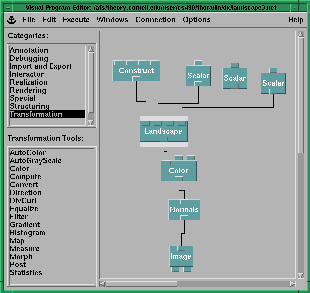Getting the files / Setting up
In order to use the landscape module, you will need to obtain the source,
and compile it into your Data Explorer exec. This is not half as difficult
as it may seem. Hopefully the following steps will get you up and going.
- First download the tar'ed and gzip'ed files. To do so set "Load to
local Disk" (under "Options") to on. Then click
here . Then turn "Load to
local Disk" off.
- Make a landscape directory "mkdir landscape". And copy the file to
the directory "cp landscape.tgz landscape". Goto the directory
"cd landscape"
- Uncompress the files "gzip -d landscape.tgz". Untar the files
"tar -xvf landscape.tar"
- The files are now on you system and ready to be compiled. If you
have an RS/6000 and a setup similar to the Theory Center, you can
simply type "make landscape" and the dxexec will be compiled for
you. If this doesn't work, nag your local system administrator for
help, or mail me with the problem (
jga1@cornell.edu ).
The files should now be set up and ready to use.
Starting up Data Explorer
When you compiled the new "Data Explorer" you simply created a new "dxexec"
in your current directory. In order to use the module, you need to
tell DX that you want to use the new exec and the location of the module.
Follow these steps:
- Type "dx -exec ./dxexec" to start the new data explorer session.
- Now choose "Load Module Description(s)..." under "File".
- Choose "landscape.mdf" from the file dialog.
Under the "Realization" list a new module "Landscape" should have
appeared. If not something went wrong. Start again, and if it still
doesn't work contact your sysadm or me.
Using the module
There really isn't much to using the Landscape module, as long as you
are familiar with Data Explorer. There are a few points to note however:
- The left most input of the module expects a 2-d field. The one
restriction is that the width of the field be a power of two.
For example: 16x16, 64x64, 128x128 . . .
- The second input is for the h parameter. For any of you who know
fractals h = 1/fractal dimension. Therefor as h increases the
landscape becomes less eradic.
- The third input is the seed parameter. When the seed is changed
and new landscape will be formed. However, as long as the seed
remains constant the landscape will not change. This is useful
in generating a "specific" landscape. If you have found a certain
seed that works well, you can keep that constant and vary the
h and sigma until you obtain "nice" results.
- The last input is for the sigma parameter. This varies the "height"
of the changes in the landscape. For low sigma the landscape will
be fairly flat, for larger sigma you will generate high peaks and
low crevices.
Included with the files are two Data Explorer "nets" (landscape1.net and
landscape2.net). Hopefully these will get you started in creating your
own worlds. The first net is almost as simple as it gets, the landscape
takes one input from a "construct" and the three parameters are feed in
by scalars accessible through the "control pannel". The output of the
landscape module then goes thorugh a "colors and "normals" and finally to an
"image" module. What follows is picture of the "simple" net.
Click on the picture to see a full size view.

Final Notes
I hope you enjoy playing with this module as much as I enjoyed creating it.
I'd like to extend a gracious thanks to all those who made this possible,
as well as all those who helped with "Data Explorer's cryptic programming":
- Bruce Land (one hell of a great guy. With out him, this wouldn't have
been possible)
- Frank (for programming hints and final image scrutiny)
- Chris and Greg (for being "so proud")
jga1@cornell.edu

Cornell Theory Center





